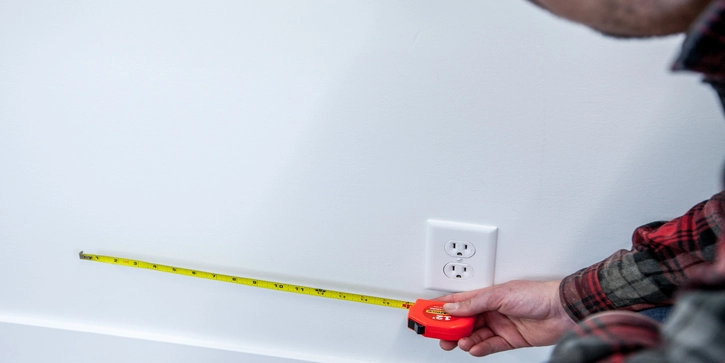How to Find a Stud Without a Stud Finder

Just have a couple of quick questions. Jump to more Mr. Handyman quick answers about How To Find A Stud Without A Stud Finder.
Can I find a wall stud by measuring?
Can you use your phone as a stud finder?
Why is it important to find a stud when hanging heavy items?
What should I do if I still can't find a stud?
Many home projects require specific tools and some expertise to use them. For example, if you’re taking on an interior construction project, you’ll likely need a stud finder to locate the studs within the walls of your home. However, not all homeowners have a stud finder, and the number of times you’ll need it usually doesn't justify purchasing one. With this in mind, here are some tips on how to find a stud without a stud finder. Before learning how to find a stud in a wall, you should know some basic information about wall construction. Although every house is unique, most homes are built using standard construction methods.
7 Ways to Find Wall Studs Without a Stud Finder
Most homes are built using 2x4 or 2x6 studs, which are typically located on the sides of windows and doors. Most outlets and light switches will have a stud on the right or left side. The trim in your home, such as baseboards, crown molding, and other decorative finishing is usually nailed to a stud. Now that you know some of the places you are most likely to find studs, let’s learn how to find a stud without a stud finder.
- The Knock Test. One way to find a stud without a stud finder tool is to knock or tap the area with a hammer or screwdriver handle. Knock gently, so you don't damage your drywall. Make sure the room is quiet so you can hear if your tapping makes a hollow sound. A hollow sound indicates there is no stud present, so continue to gently tap to the left and right until you locate the stud. When the sound becomes muffled, you've found a stud. To confirm, make a fist and hit the wall with the palm side of your hand. If it feels solid, that’s your stud. Mark the spot and measure 16" to the left and right to identify the rest of the studs, if needed.
- Use a Magnet. This method may seem a bit unorthodox, but it works! Use tape or dental floss with a magnet attached and drag it across the wall to find the stud. This method works because the metal screws used to secure the drywall are typically secured to a stud. Wait until the magnet sticks to the wall and mark the location of the stud—it's that easy.
- Side note: If you're having trouble finding the stud, try a stronger magnet. It’s also possible that your drywall is secured with adhesive instead of screws. If this is the case, you'll need to try a different stud-finding method.
- Measure from the Corner. Since studs are generally 16″ apart from center to center, learning how to find wall studs is pretty easy using measurements that start in the corner of the room. Keep in mind that all rooms aren't built with studs that are 16" on center, so there is a chance you’ll find a stud less than 16″ from one corner. Use the “knock test” near the corner to determine where the shorter stud spacing might be and to confirm the location of other studs.
- Check the Trim. The baseboards, door trim, and window casements in your home are usually attached to the studs. Check your baseboards to see if you can spot where it has been nailed. These holes are usually painted over and filled with caulk which often creates a dimple. When you locate one of these dimples, measure out in 16″ increments to locate the additional studs.
- Use Switchplates and Windows As a Guide. At least one side of an outlet and light switch will be mounted to a stud, and windows are too. Windows usually have a stud on each side, but trimwork can make finding the stud tricky. Start with outlets and light switches for the quickest and most accurate results. Tap the sides of the outlet to locate which side has the stud support. Measure about 3/4″ away from the outlet on the stud side and use that as a starting point to determine the 16″ intervals.
- Try the “Hit and Miss” Technique. Drive a thin nail into the wall where you suspect there is a stud. If the nail doesn't hit any wood, remove it and insert a wire hanger into the hole. Twist the hanger inside the cavity until it hits the nearest stud. While it’s still in the wall, pinch the hanger with your fingers to mark how much of it is in the wall. For precision, pull the hanger out (while keeping your fingers as a marker) and measure the length of the hanger that was in the wall. Then, measure the same distance on the outside of the wall to mark your stud.
Still can't figure out how to find studs without a stud finder? Remember, DIY doesn't mean you have to do it all by yourself! Whether you use our handy home repair and maintenance guides or one of our professional residential services, we want you to have a home you enjoy. From repairs and maintenance to remodels and makeovers, Mr. Handyman is your one-stop resource for all your home projects. No matter which services you choose, every job comes with an experienced professional and our Done Right Promise. Contact Mr. Handyman by calling to request service today.
This article is intended for general guidance only and is not applicable to every situation. You are responsible for determining the proper course of action for your property and situation. Mr. Handyman is not responsible for any damages that occur as a result of advice and/or guidance derived from its blog content. Some Mr. Handyman services vary by location. Contact your local Mr. Handyman franchise for more information.
FAQs About Finding a Stud Without a Stud Finder
Mr. Handyman has been helping homeowners repair, maintain, and enhance their spaces for over 25 years! We are the one-stop solution for everything on your to-do list. This includes answering your questions about home repairs, maintenance, and improvements. Here are answers to some of your most frequently asked questions about finding a stud without a stud finder.
Can I find a wall stud by measuring?
Yes, measuring is a fairly reliable method to find studs without a stud finder. Most studs in modern construction are spaced either 16 or 24 inches apart, measured from the center of one stud to the next. Start from a corner or an outlet (somewhere you know a stud to be) and measure in intervals of 16 inches across the wall, using tapping or visual clues for confirmation.
Can you use your phone as a stud finder?
Yes, you can use your phone as a basic stud finder with the help of certain apps that utilize your phone’s built-in magnetic sensor to detect metal fasteners in the wall. These apps won’t directly show you where the stud is, but they can help you locate nails or screws, which are usually driven into wall studs. It’s a helpful option when you're learning how to find a stud in the wall without tools—but for best results, always verify findings with physical clues like outlet placement or wall tapping.
Why is it important to find a stud when hanging heavy items?
Studs provide the structural support necessary for safely hanging heavy items like TVs, mirrors, or shelves. Mounting directly into drywall can cause damage or failure over time. When you know how to find a stud in the wall without tools, you reduce the risk of drywall anchors pulling loose and ensure your installation lasts.
What should I do if I still can't find a stud?
If you’ve exhausted all stud-finding methods without success, it might be time to call in an expert. Mr. Handyman service professionals bring over a decade of experience and the right tools to handle your wall mounting needs safely and correctly. Whether you’re hanging a TV or installing shelves, we’re here to help get the job done right—the first time.
Still have questions about wall installations, how to find a stud without a stud finder, or how to repair drywall? Explore more expert tips on our Mr. Handyman Blog, or contact your local Mr. Handyman to schedule a service today. We’re proud to back every service—start to finish—with the Neighborly Done Right Promise® to ensure your satisfaction.
 Click to call
Click to call


